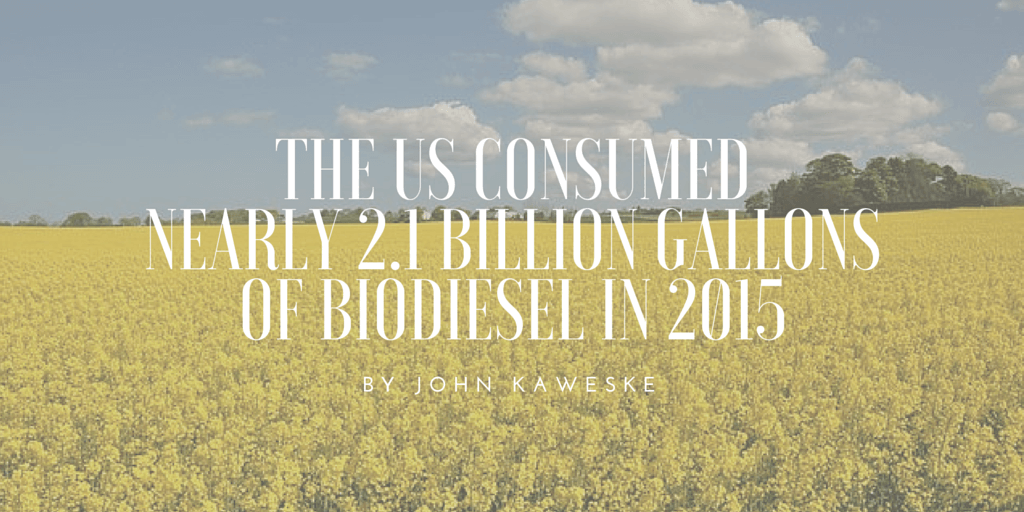The United States hit a new record for biodiesel consumption in 2015, using nearly 2.1 billion gallons over the course of the year.
This positive shift towards renewable energy sources has resulted in reducing America’s carbon emissions by at least 18.2 million metric tons, according to new U.S. EPA data released during the 2016 Biodiesel Conference & Expo.
Biodiesel is America’s first and only EPA-designated advanced biofuel to reach commercial-scale production nationwide. To meet the EPA’s definition of an advanced biofuel, it must reduce greenhouse gas emissions by more than 50 percent when compared with petroleum diesel. The growing consumption of biodiesel demonstrates the huge success the biodiesel industry is seeing as its popularity continues to rise. According to the latest data, fuel companies reported producing 2.09 billion gallons of biodiesel in 2015, up from about 1.97 billion gallons in 2014, and that is only expected to increase in 2016.
As the CEO of the National Biodiesel Board Joe Jobe explained, “We’re seeing it take hold across the country. Consumers are seeking out cleaner alternatives to fossil fuels and they see biodiesel as a high-performing, cost-competitive alternative to petroleum diesel. These numbers also show without question that the renewable fuel standard (RFS) is delivering significant volumes of advanced biofuel to the American people. They prove that the RFS is absolutely working.”
“Biodiesel is still a young industry,” Jobe continued, “but it is becoming a mainstream American fuel that’s having a real impact in helping us cut pollution, create jobs and diversify the fuels market.”
Biodiesel’s success, as opposed to other renewable energy sources, can be attributed in good part to a few main factors. First, it’s a renewable, clean-burning alternative that can be used in existing diesel engines. Diesel engines don’t require any new equipment or alterations in order to begin using it.
Second, as the science behind it’s development continues to progress, biodiesel is being able to be made from an increasingly diverse mix of resources. Form recycled cooking oil and soybean oil to animal fats and corn stover, biodiesel can be created from a variety of ingredients, which means that it’s not limited to a single ingredient, process, or waste.
There is, however, one major concern that was also recognized in the latest data. As imports increasingly flood the U.S. market, U.S. production is getting undercut.
According to the data, domestic production has remained relatively flat at about 1.42 billion gallons when compared to the 1.47 billion gallons consumed in 2014 and 1.50 billion gallons in 2013. Meanwhile, imports rose more than 25 percent from 510 million gallons in 2014 to an estimated 670 million gallons in 2015.
Jobe shared his thoughts as such, “While the overall numbers are positive, we are increasingly seeing subsidized, predatory imports undercutting U.S. production—in part by taking advantage of U.S. policies aimed at building up the domestic industry. This is exactly what we have been warning would happen, and it will continue until we take steps to level the playing field, including by reforming the biodiesel tax incentive as a domestic production credit.”
As I’ve discussed in previous blog posts, the NBB wants Congress to reform the $1-per-gallon biodiesel tax incentive from a blender’s credit to a producer’s credit. Under the laws existing structure, biodiesel that is produced overseas and blended in the U.S. can take advantage of the incentive, meaning the U.S. tax benefit ultimately ends up helping foreign producers. Most imports already receive valuable incentives overseas that U.S. companies are typically barred from taking advantage of. This means the cost of producing biodiesel is consequently much higher when it is produced in the U.S.
Leaders in the U.S. biodiesel industry feel that these foreign companies are “double-dipping” on overseas and U.S. incentives, which make it impossible for U.S. companies to compete in their own domestic markets.
Imports currently remain to be a threat, but stronger policies have begun to be implemented since late last year. In November, after years of delays, the EPA finalized new biomass-based diesel standards under the Renewable Fuel Standard (RFS) requiring 1.9 billion gallons in 2016 and 2 billion gallons in 2017. And in December, Congress reinstated the biodiesel blender’s tax incentive through the end of the year, after it had previously lapsed in 2015.
There are still many challenges on the road ahead, but most of us believe that 2016 will be the biggest year yet for biodiesel.

